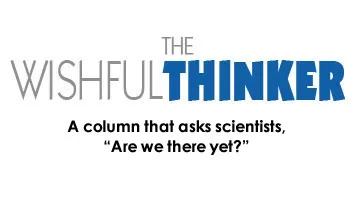Seeking Friendlier Skies
Can radar networks eliminate airplane turbulence?
/https://tf-cmsv2-smithsonianmag-media.s3.amazonaws.com/filer/turbulence-631.jpg)
There's an episode of "Seinfeld" in which Kramer and the recurring character Mickey play rock-scissors-paper, for no other reason than to pass the time. Kramer chooses paper and Mickey chooses rock, yet Mickey proclaims victory. "Rock flies right through paper," he says. After a moment, they conclude that nothing, in fact, beats rock, and proceed to play a couple more rounds that end in rock-rock stalemates.
Just as Mickey thinks rock can slash through paper, I've always felt that massive airplanes should be able to zip through clouds without creating the bumps and jolts all too familiar to air travelers. At the very least, pilots should have enough advanced notice to elude these atmospheric obstacles.
So when can we truly call the skies "friendly"? When can we contour our limbs into those tiny airplane seats and eat our package of five pretzels in peace?
Turbulence is the result of powerful and unpredictable shifts in wind direction and velocity, usually brought on by thunderstorms and clouds. As a storm brews, cloud tops and precipitation create vertical shear—swirls of wind gusting up and down. These eddies of air can push plane wings in opposing directions, jostling an aircraft as a boat on wavy waters.
Pilots learn about turbulence in a couple ways. Often they overhear radio reports from other planes. Sometimes ground controllers pass along these reports to planes approaching bumpy patches, sometimes they don't. As it stands, for one pilot to learn about turbulence pretty much means another pilot elsewhere has already encountered it.
When a thunderstorm is detected, Federal Aviation Administration guidelines recommend that a pilot fly 20 miles around it, even if some air within that space is smooth. This procedure can lead to delayed landings and extra fuel costs—presumably passed on to consumers—creating another sort of turbulence, of patience and paycheck.
Fortunately for atmospheric scientists, a nationwide radar network gathers information about precipitation, cloud density, wind speed and gustiness. These data can be analyzed to create a map of turbulence. In the past, however, radar has had trouble distinguishing actual turbulence producers from data contaminants. A heavy swarm of insects can look to radar just like droplets of water, especially at night. As a result, previous attempts to use such a system have over-warned pilots, and thus been abandoned.
Within the past decade, however, scientists have improved the mathematical algorithms that interpret information gathered by radar. Computers can recognize true gusts of wind from packs of birds and bugs with greater precision. They can filter out data spoiled by sunlight or nearby, but unrelated, storms. The process is self-serving: as these data models accumulate more accurate information, they become better at identifying actual turbulence.
This weather information can be combined with airline flight plans to produce customized turbulence alert maps. As often as every five minutes, pilots can print out these maps and see what's going on in front of them for the next hundred or so miles. Instead of anecdotal, sporadic reports, pilots now have a nearly real-time sense of impending turbulence.
Such a futuristic system already exists in an early phase. United Airlines is testing it out right now. However, it comes with limitations. Pilots are not allowed to use these turbulence maps alone to alter a route—only to turn on the fasten-seatbelt sign. In addition, cockpits do not have electronic feedback monitors, and, to save money, the maps are only available for pilots to print in cases of significant turbulence.
The current system contains another major shortcoming: about one-third of turbulence isn't caused by either thunderstorms or clouds at all. Rather, this "clear air" turbulence is caused by vertical shear produced by the jet stream—essentially a river of air—or by waves made as air passes over mountains.
A system that takes into account all types of turbulence is in the works. In the meantime, stow your tray table and strike up a game of rock-scissors-paper with the person next to you. But choose rock at your own risk.
The real Wishful Thinker behind this column was John Williams at the National Center for Atmospheric Research, who predicts that advanced turbulence monitors could be used in commercial cockpits by 2011.
Have an idea that should be thought about wishfully? Send it to [email protected].
/https://tf-cmsv2-smithsonianmag-media.s3.amazonaws.com/accounts/headshot/eric-jaffe-240.jpg)

/https://tf-cmsv2-smithsonianmag-media.s3.amazonaws.com/accounts/headshot/eric-jaffe-240.jpg)